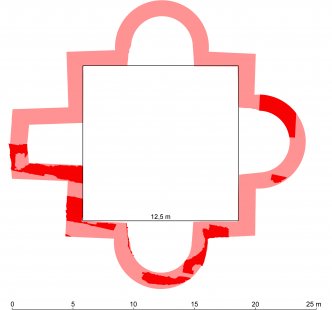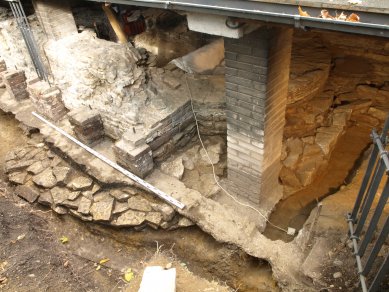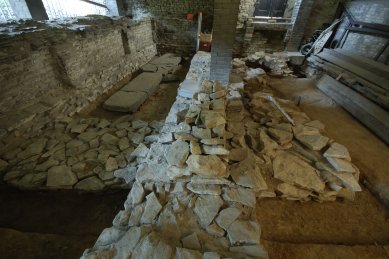
The discovered church at Vyšehrad is likely to change the perspective on Czech history
Prague - The previously unknown oldest church at Prague's Vyšehrad, the foundations of which have been partially uncovered by archaeologists from the Academy of Sciences in recent days, will undoubtedly change the perception of the character of the oldest Czech architecture. Ladislav Varadzin, an archaeologist from the Archaeological Institute, told ČTK today. According to him, the floor plan type of building was unknown in Central Europe, and moreover, not in such dimensions. The find may also change the understanding of the Cyril and Methodius tradition in the territory of Bohemia and Moravia and the beginnings of Vyšehrad. The prototype of the church may originate from a Byzantine environment.
Archaeologists, as part of their exploration in the area of the Vyšehrad Basilica of Saint Lawrence, discovered fragments of an unknown church and its main apse. The building with three apses, which is not known even from written sources, dates back to the second half of the 10th century to the first half of the 11th century. It is thus the largest building with a central floor plan not only in the Czech Republic but also in the West Slavic area. Until now, it was believed that the largest building with a central floor plan was the rotunda of St. Vitus at Prague Castle.
Varadzin reminded that buildings with a central floor plan were very demanding in terms of statics. Their main feature was height. "According to the discovered masonry, the building was 25 meters long and was 40 percent larger than the rotunda of St. Vitus and St. Wenceslas at Prague Castle. Its area was absolutely monumental," added archaeologist Bořivoj Nechvátal, who has been researching Vyšehrad since the late 1960s.
The site is hidden from the public in the garden of the Vyšehrad Chapter. Archaeologists will complete their exploration on Friday, and at the beginning of next week, the site will be buried. The research will then be moved to laboratories. "The fact that things are found in our garden that radically change the view of the beginnings of Christianity in the Czech lands is a great joy... the search for the roots of Czech statehood is something that belongs to the identity of the chapter," said Tomáš Holub, Secretary General of the Czech Bishops' Conference to ČTK. The project has financially contributed, for example, royal collegiate chapter at Vyšehrad and the city hall.
"Such a building with such dimensions must have been designed by someone with experience. We can ask where they came from. Surely not from these regions," noted Varadzin. Archaeologists believe that the builder could have come from a Byzantine environment or from an environment familiar with this type of construction. According to Varadzin, the question is why the Přemyslids didn't make do with a rotunda or a basilica.
The location of the church was determined by archaeologists with a twenty-centimeter accuracy. Human and animal skeletal remains were also found from the cemetery around the Basilica of St. Lawrence, which illustrate the demography and life of the inhabitants of Vyšehrad in the 11th and 12th centuries.
Vyšehrad is a historical fortification on a rock above the right bank of the Vltava River in Prague and the district of the same name nearby. A number of legends are associated with it. According to one of them, it was founded by the legendary prince Krok. It originated as a princely stronghold in the second half of the 10th century, and by the end of the 11th century, the first Czech king, Vratislav II, resided there. Later, it became a fortress guarding Prague from the south. From the 15th to the 19th century, Vyšehrad with its surroundings was an autonomous town, and in 1883 it was annexed to Prague.
On its territory stands the Church of St. Peter and Paul, where the Vyšehrad Chapter was established in the 11th century; in the 19th century, the originally Gothic temple was rebuilt in a neo-Gothic style. Next to it, the Vyšehrad Cemetery began to emerge as a national burial site for prominent personalities, with the Slavín mausoleum built at its forefront. Since 1962, the landscaped Vyšehrad area has been a national cultural monument. The rotunda of St. Martin on the territory of Vyšehrad is the oldest rotunda in Prague.
Archaeologists, as part of their exploration in the area of the Vyšehrad Basilica of Saint Lawrence, discovered fragments of an unknown church and its main apse. The building with three apses, which is not known even from written sources, dates back to the second half of the 10th century to the first half of the 11th century. It is thus the largest building with a central floor plan not only in the Czech Republic but also in the West Slavic area. Until now, it was believed that the largest building with a central floor plan was the rotunda of St. Vitus at Prague Castle.
Varadzin reminded that buildings with a central floor plan were very demanding in terms of statics. Their main feature was height. "According to the discovered masonry, the building was 25 meters long and was 40 percent larger than the rotunda of St. Vitus and St. Wenceslas at Prague Castle. Its area was absolutely monumental," added archaeologist Bořivoj Nechvátal, who has been researching Vyšehrad since the late 1960s.
The site is hidden from the public in the garden of the Vyšehrad Chapter. Archaeologists will complete their exploration on Friday, and at the beginning of next week, the site will be buried. The research will then be moved to laboratories. "The fact that things are found in our garden that radically change the view of the beginnings of Christianity in the Czech lands is a great joy... the search for the roots of Czech statehood is something that belongs to the identity of the chapter," said Tomáš Holub, Secretary General of the Czech Bishops' Conference to ČTK. The project has financially contributed, for example, royal collegiate chapter at Vyšehrad and the city hall.
"Such a building with such dimensions must have been designed by someone with experience. We can ask where they came from. Surely not from these regions," noted Varadzin. Archaeologists believe that the builder could have come from a Byzantine environment or from an environment familiar with this type of construction. According to Varadzin, the question is why the Přemyslids didn't make do with a rotunda or a basilica.
The location of the church was determined by archaeologists with a twenty-centimeter accuracy. Human and animal skeletal remains were also found from the cemetery around the Basilica of St. Lawrence, which illustrate the demography and life of the inhabitants of Vyšehrad in the 11th and 12th centuries.
Vyšehrad is a historical fortification on a rock above the right bank of the Vltava River in Prague and the district of the same name nearby. A number of legends are associated with it. According to one of them, it was founded by the legendary prince Krok. It originated as a princely stronghold in the second half of the 10th century, and by the end of the 11th century, the first Czech king, Vratislav II, resided there. Later, it became a fortress guarding Prague from the south. From the 15th to the 19th century, Vyšehrad with its surroundings was an autonomous town, and in 1883 it was annexed to Prague.
On its territory stands the Church of St. Peter and Paul, where the Vyšehrad Chapter was established in the 11th century; in the 19th century, the originally Gothic temple was rebuilt in a neo-Gothic style. Next to it, the Vyšehrad Cemetery began to emerge as a national burial site for prominent personalities, with the Slavín mausoleum built at its forefront. Since 1962, the landscaped Vyšehrad area has been a national cultural monument. The rotunda of St. Martin on the territory of Vyšehrad is the oldest rotunda in Prague.
The English translation is powered by AI tool. Switch to Czech to view the original text source.



0 comments
add comment










